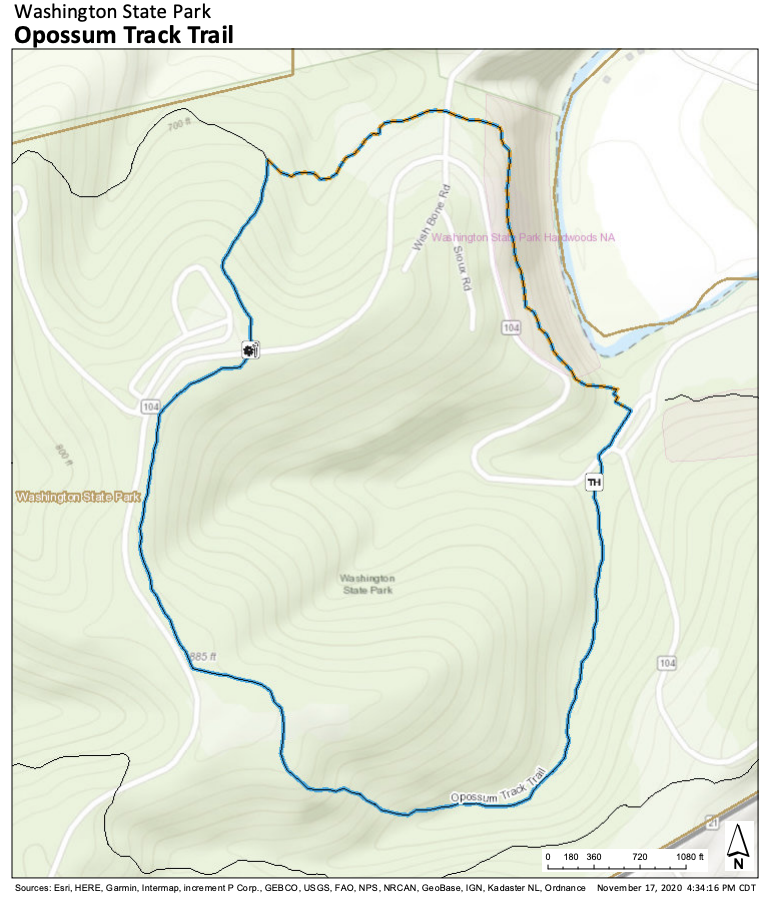1,000 Steps Trail
1.5 Miles
Constructed by the Civilian Conservation Corps in 1936. Most of the rock work in the park is a result of their efforts, including the large stone steps that give 1,000 Steps Trail its name. After climbing the stone steps through the oak and hickory forest, you will encounter a beautiful overlook shelter where you will enjoy a spectacular view before continuing on your way.
This is a moderately difficult trail. You will encounter several bridges and stone walkways that may be slippery, rocks and roots that may be sticking up in the trails natural surface, and steep grades traversed by uneven stone steps.
1000 Steps Trail Map:

Opossum Track Trail
2.5 Miles
Opossum Track Trail winds through a section of the 68-acre Washington State Park Hardwood Natural Area, an area of land set aside for protection because of its natural beauty. Along sections of the trail, you will notice depressions in the earth which seem un-natural. Prior to the parks construction, this area was prospected for a mineral called barite, locally known as tiff. The depressions are the remains of those prospecting operations.
As you hike along this scenic trail, you may also enjoy several breath-taking views of the Big River valley, particularly near the Civilian Conservation Corps overlook. The trail meanders through a typical Missouri oak-hickory hardwood forest, abounding with seasonal wildflowers, songbirds, native wildlife, majestic trees, and trickling water winding its way along an ancient creek bed.
Opossum Trail Map:

Rockywood Trail
6 Miles
Backpacking
Rockywood Trail provides a glimpse of the other two trails, 1,00 Steps Trail and Opossum Track Trail, in that it joins each of these two trails for a time as it winds through the parks oak/hickory forested hills.The trail also traverses a section of the parks 68-acre Washington State Park Hardwood Natural Area, an area of land set aside for protection because of its natural beauty. Several glades are present along the trail and you may see evidence of fire in these areas. This is part of an ongoing glade management program that has helped restore these glades to their historic nature. This process allows for frequent controlled burns and the removal of invasive cedar trees. In the past natural fires would sweep through these areas and keep the understory growth (including cedar trees) in check. Times have changed, and now the park staff uses control the use of fire to preserve these ancient landscapes. You may spot an Eastern Collared Lizard or Missouri Tarantula darting across the trail, or enjoy the beautiful glade wildflowers that now sprout from the rocky terrain each spring. Examples include Milkweed, Prickly Pear Cactus, and Coneflowers. Rockywood Trail also passes by a quarry (behind the camp ground) that provided the Civilian Conservation Corps workers with the stone used to build many of the parks historic structures. A backpacking camp is located about a third of the way along the trail. No amenities are provided at the camp and you are asked to “Leave No Trace” when using the backpack camp. Backpackers should register at the park office or at Thunderbird Lodge before beginning their hike; further information on the trail and backpack camp will be provided upon registration.
This trail is moderately difficult. Along this trail you will encounter slippery conditions, rocks and roots sticking up in the trails natural surface, steep glades, and creek crossings without bridges.
Rockywood Trail Map:

